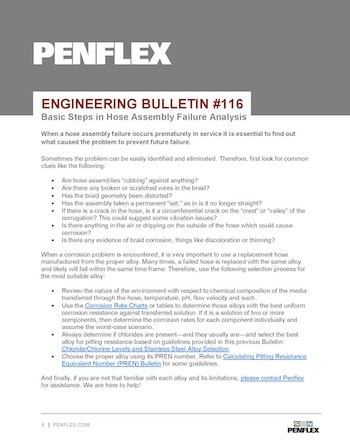Basic Steps in Hose Assembly Failure Analysis
When a hose assembly failure occurs prematurely in service it is essential to find out what caused the problem to prevent future failure. Sometimes the problem can be easily identified and eliminated, therefore first look for common clues like the following:
- Are hose assemblies “rubbing” against anything?
- Are there any broken or scratched wires in the braid?
- Has the braid geometry been distorted?
- Has the assembly taken a permanent “set,” as in is it no longer straight?
- If there is a crack in the hose, is it a circumferential crack on the “crest” or “valley” of the corrugation, suggesting some vibration issues?
- Is there anything in the air or dripping on the outside of the hose which could cause corrosion?
- Is there any evidence of braid corrosion, things like discoloration or thinning?
When a corrosion problem is encountered, it is very important to use a replacement hose manufactured from the proper alloy. Many times a failed hose is replaced with the same alloy and likely will fail within the same time frame. Therefore use the following selection process for the most suitable alloy:
- Review the nature of the environment with respect to chemical composition of the media transferred through the hose, temperature, pH, flow velocity and such.
- Use the Corrosion Rate Charts or tables to determine those alloys with the best uniform corrosion resistance against transferred solution. If it is a solution of two or more components, then determine the corrosion rates for each component individually and assume the worst-case scenario.
- Always determine if chlorides are present-and they usually are-and select the best alloy for pitting resistance based on guidelines provided in this previous Bulletin: Chloride / Chlorine levels and Stainless Steel Alloy Selection.
- Choose the proper alloy using its PREN number. Refer to Calculating Pitting Resistance Equivalent Number (PREN) Bulletin for some guidelines.
And finally, if you are not that familiar with each alloy and its limitations, let us know – we are here to help!
